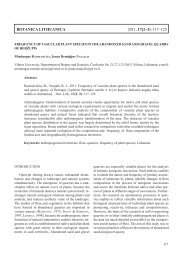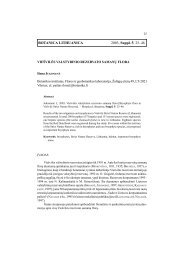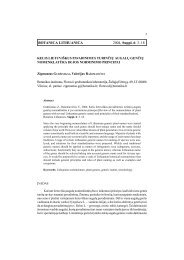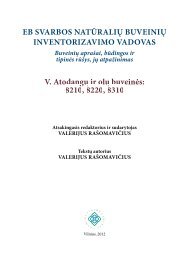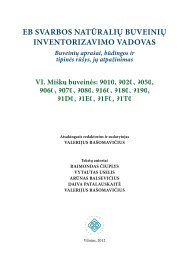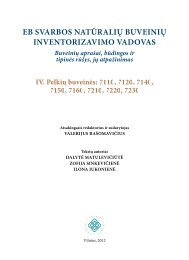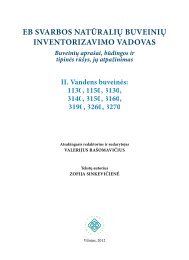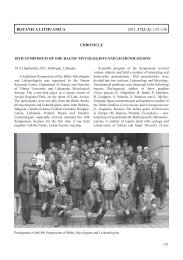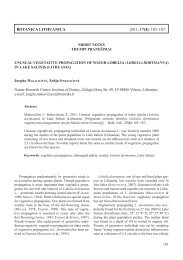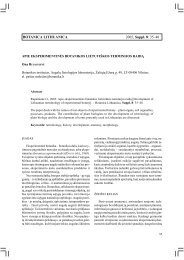FUNGI AND LICHENS IN THE BALTICS AND BEYOND XVIII ...
FUNGI AND LICHENS IN THE BALTICS AND BEYOND XVIII ...
FUNGI AND LICHENS IN THE BALTICS AND BEYOND XVIII ...
Create successful ePaper yourself
Turn your PDF publications into a flip-book with our unique Google optimized e-Paper software.
The frequency more than 10% showed 31 species, among them only one was not found in all<br />
three mountain ranges. Destroyed spruce stands seem to be key habitats for many lichen<br />
species listed as threatened taxa in recent national Red List of Lichens. Some of them are<br />
frequent there, e.g. Chaenotheca xyloxena (frequency 21%; VU), Lecidea turgidula (20%;<br />
VU) and Calicium trabinellum (19%; EN); next 15 threatened species are common for the<br />
three ranges, but more rarely found. Among them are also other endangered taxa (category<br />
EN) in Poland: Chaenotheca brunneola, Ch. stemonea and Lecanactis abietina. Buellia<br />
arborea, Puttea margaritella and Phaeopyxis varia are presented as new to Poland and the<br />
last species additionally as new for Central Europe and Carpathians. For these and several<br />
noteworthy species taxonomical remarks and some details on ecology and world distribution<br />
are included.<br />
ROLE OF <strong>THE</strong> FENNOSC<strong>AND</strong>IAN GREEN BELT <strong>IN</strong> CONSERVATION OF<br />
<strong>THE</strong> LICHEN BIOTA <strong>IN</strong> EASTERN FENNOSC<strong>AND</strong>IA<br />
M. A. FADEEVA, A. V. KRAVCHENKO<br />
Forest Research Institute, Karelian Research Centre of RAS,<br />
11 Pushkinskaya Str., 185910 Petrozavodsk, Republic of Karelia, Russia<br />
E-mails: fadeeva@krc.karelia.ru, alex.kravchen@mail.ru<br />
The Green Belt of Eastern Fennoscandia (GBEF) stretches from south to north along<br />
the Russian-Finnish and Russian-Norwegian border within Finland, Norway and Russia –<br />
Republic of Karelia, Leningrad and Murmansk Regions. Owing to its borderland location and<br />
remoteness from industrial centres, extensive – 50,000 ha and more – areas of pristine taiga,<br />
Europe’s westernmost ones, have survived in GBEF. This fact makes GBEF the key element<br />
of the East Fennoscandian ecological framework – the system of taiga corridors which<br />
enables native flora and fauna to disperse freely – and a crucial prerequisite for conservation<br />
of the region’s original biodiversity (Kurhinen et al., 2009, 2011, etc.). On the Russian side,<br />
GBEF comprises operating and several planned protected areas (PAs) with the federal (two<br />
strict nature reserves, two designated national parks and one scheduled for designation in<br />
2011) and regional status (nature park, nature reserves).<br />
In the present paper we assess the role of PAs of Karelia and the Murmansk Region<br />
within GBEF in conserving nationally and regionally red-listed species of lichens and allied<br />
fungi.<br />
Lichenological data are analysed for 8 operating and planned PAs in Karelia and 2 in<br />
the Murmansk Region. All in all, 80 (73.4 % of the total number) regionally red-listed species<br />
have been found in PAs of Karelia. GBF PAs alone harbour 18 (16.5 % of the total number of<br />
red-listed species). PAs of the Murmansk Region host 53 such species (41.7 % of the total<br />
number). Three PAs stand out in terms of the number of species they harbour: operating<br />
Paanajärvi NP and planned Ladoga Skerries NP in Karelia, and Kutsa nature reserve in the<br />
Murmansk Region with 41 (37.6 % of the total number of red-listed species), 61 (56.1 %) and<br />
45 (35.4 %) red-listed species, respectively. The number of red-listed species in other PAs<br />
ranges from 3 (2.8 %) to 18 (14.2 %).



